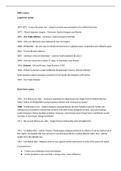Interview
Succinct and informative IB SL History summary of WW1 and WW2
- Module
- Institution
- Book
The document includes informative summary of WW1 causes, practices, consequences and WW2 causes: the failure of collective security. Hitler's war. Hitler and short term causes of WW. Hitler, Poland, the Nazi-Soviet Pact. Appeasement as a cause of WW2. A 7 was my main grade for 1 year and a half ...
[Show more]




